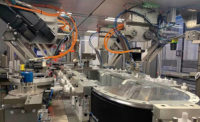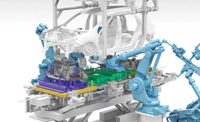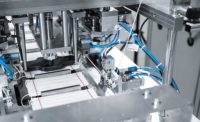1 // HEROIC EFFORT PRODUCES MACHINE IN JUST EIGHT WEEKS
Lanco Integrated has completed an assembly system to produce components for coronavirus test kits. Typically, designing and building such a machine would take 35 weeks. Lanco had it ready in just eight weeks.
“When the request came in…I immediately thought, ‘This is crazy,’” says Jake Rollins, a Lanco engineer. “We can’t build a machine in eight weeks. But then my next thought was, ‘There has to be a way to do it.’”
The project was commissioned by Dutch medical company QIAGEN at the onset of the pandemic. The machine would need to assemble 6,000 parts per hour.
Working remotely, the Lanco team developed processes on the fly. “For material procurement, for example, we were preordering stuff before we were typically ready to, knowing that we had to…bet on what we were going to use [so we could] receive it on time,” says Rollins.
The design phase, which would normally take five to six weeks, was completed in six days. “We were working seven days a week until midnight or 2 a.m. to get everything pushed through,” says Rollins.
2 // STANDARD MACHINE MAKES FACE MASKS
IMA Automation has introduced a standard machine to automatically produce face masks. The IMA FACE 400 consists of two machines: a converting system and a packaging system. The masks consist of three layers of nonwoven material, a nose clip and two elastic bands. The converting system assembles the materials using ultrasonic welding. The clip and bands are attached with hot-melt adhesive. The system can produce 200 to 400 masks per minute.
3 // AUTOMATED SYSTEM PACKS BATTERIES
Isthmus Engineering & Manufacturing has designed and built an automated system for packaging hearing aid batteries.
Batteries are presented to the system on trays. SCARA robots transfer the batteries to a test station for a voltage check, and then to a fixture for presentation to one of four delta robots. The deltas transfer batteries to a disposable dial-shaped package, which is fed by a vibratory bowl.
The packages are then transferred downstream via conveyor for receipt of blister covers, which are also fed via vibratory bowls, and preprinted cards, which are fed via a carousel magazine. Completed packages go through a heat seal system and vision inspection. Approved packages are transferred to a laser marker and then to an offline boxing station.
4 // INTEGRATOR REHABS 33-YEAR-OLD MACHINE
An ammunition manufacturer needed to increase the production rate of an existing machine for painting the tips of bullets. Built in 1987, the machine was worn out and did not meet the latest safety standards.
Systems integrator Computech disassembled and evaluated the machine. The framing was repainted, and the system was rebuilt with new drive components and bearings. The controls were upgraded, and the equipment was retrofit to meet safety standards. The machine also got a new paint system and a vision sensor to inspect the bullets. To combat paint buildup on the indexer, Computech installed a scraping mechanism that operates every 10 minutes to remove overspray. The refurbished machine paints 1,200 parts per minute.
5 //
In April, ATS Automation Tooling Systems received a $60 million order from an automotive manufacturer to design and build two fully automated battery assembly systems.







